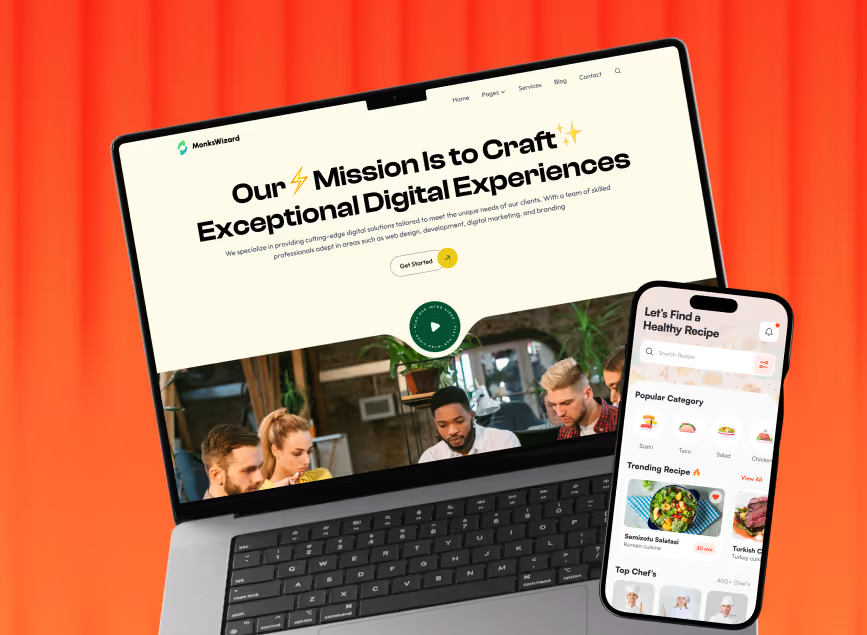
Key Takeaways
User-centered design is a particular and highly demandable approach that keeps users’ needs, preferences, and behavior in the first place. It’s not just a method; it’s a way of saying, “Let’s make something awesome for the people who will use it.” This means lots of listening, learning, and tweaking until it’s perfect.
However, if you are new to learning about this design approach, we can help. Today, we’ll explain UCD in simple terms. We’ll talk about its principles, benefits, and how this one differs from the traditional one.
Plus, we’ll give you easy steps to follow so you can use UCD in your own projects. Ready to learn how to make things that people love? Then, keep reading till the end.
What is User-Centered Design?

User-centered design is shortly known as UCD. It is a popular design approach that solely focuses on the end users and their needs, preferences, and abilities regarding the product. Generally, UCD aims to create digital products, systems, or services in an intuitive and efficient way keeping in mind the people who will use them.
In this approach, the designers first understand the users’ perspectives and make a plan about how to involve them in the design process. They make necessary customization based on their feedback to create a final product.
According to East Agile,
“Being human-centered is an additional cost to any project, so businesses rightly ask whether taking so much time to talk to people, produce prototype designs, and so on is worthwhile. The answer is a fundamental ‘yes’.”
David Benyon (Professor with over 25 years of experience in the field of HCI)
There are 4 basic elements of user-centered design. To understand the entire fact of UCD, we should understand these elements first.
Visibility
Visibility is all about how easily users can perceive the available functions and features of a product or interface. In this section, making important elements readily apparent and clearly visible to users is the core basic.
To that, designers should utilize clear labeling, intuitive icons, and well-organized layouts. They need to make sure that users can easily find what they need.
Accessibility
Accessibility is about ensuring that the product or service is usable by as many people as possible. The user must include those with disabilities or special needs. Here, the sim is to ensure that people of all groups can access the product or system properly without facing complicacy.
For that, designers create interfaces that are compatible with screen readers. It also has to provide alternative text for images, use high-contrast colors for better readability, and implement keyboard shortcuts for users who may have difficulty with a mouse.
Legibility
The next thing that comes up is legibility. It refers to how easily users can read and understand the content presented to them. This element is all about using appropriate font sizes and styles, and sufficient contrast between text and background.
Using clear language that is easy to comprehend is another must-have in this case. Legible design is essential as it can ensure that users can quickly and accurately interpret information without unnecessary effort.
Language
The final element is the language used in the interface. Here, the tone and style of communication you used really matter. It’s essential to use language that is familiar to the target audience and free from jargon or ambiguity.
Additionally, the tone should be appropriate for the context, no matter if it’s formal, casual, friendly, or authoritative. Designers should keep in mind that language plays a significant role in shaping the user experience. Also, language can greatly impact how users perceive and interact with a product or service.
These are the basic elements of user-centered design. A designer can’t ignore any of these four matters when creating an ideal design for a digital product, service, or system.
How UCD Differs from Traditional Design Approaches
User-centered design is pretty much different from traditional approaches in several ways. You should learn the differences to understand UCD more extensively. Here’s how UCD stands apart:

Focuses on User Needs
Unlike the traditional design, UCD places a strong emphasis on the end user’s needs, preferences, and behaviors. Traditional design approaches mostly prioritize the designer’s vision or industry standards. In most cases, it doesn’t consider the actual users’ perspectives.
Always Follow An Iterative Design Process
UCD usually follows an iterative design process. Here, the designers gather feedback from users early and often. They need to continuously refine the product or service. Traditional approaches may follow a more linear process, with less opportunity for user input until later stages of development.
Make Early Prototypes and User Testing
Designers of UCD mostly create prototypes early in the design process to gather feedback from users through usability testing. This early process helps designers identify and predict usability issues before investing significant time and resources into development.
However, in most cases, traditional design approaches delay testing until later stages. Even though it increases the risk of costly redesigns, still they don’t consider the importance of user feedback as UCD does.
Emphasis Empirical Data
UCD emphasizes empathy for the end-users. It encourages designers to put themselves in the users’ shoes to better understand their experiences and challenges.
Additionally, UCD relies on empirical data gathered through user research and testing. This data informs design decisions, rather than relying solely on intuition or assumptions.
Flexible and Adaptive Approach
UCD also prioritizes flexibility and adaptability, unlike the most traditional design approaches. It lets designers make changes whenever needed according to user feedback and requirements.
Traditional approaches, on the other hand, are quite rigid and don’t leave opportunities for later adjustments once it is finalized.
As we see, user-centered design prioritizes the user of the design process the most to make products and services more intuitive, suitable, and satisfying. However, most traditional approaches prioritize the conventional way without focusing on the users’ end.
Basic Principles of User-Centered Design

Now, let’s come to the principles of user-centered design. Certainly, you can claim just any design, a user-centered one. Indeed, human-centered and user-centered are not the same thing.
There are some principles the UCD process usually follows. Let’s check them out briefly:
Must Design with Users in Mind
A user-centered design must emphasize the end user’s needs, preferences, and behaviors of the end-users throughout the process. The designers must make a design that users will feel comfortable to use.
For that, they have to conduct user research, gather feedback, and finally design in a way that truly meets what the users need.
That’s the reason, it is called a user-centered one as the center priority is the users. So, the design can’t be a user-centric one if it doesn’t consider the users’ needs and comfort.
Use Plain Language
A design should have plain language all over it so that communication becomes clear and simple. The tone and language style must avoid jargon, technical terms, or overly complex language that may be difficult for users to understand.
This principle is pretty much connected to two of the elements accessibility and language. A product design with a complex tone and language style can’t be accessible to users with less technical knowledge. That’s why it’s essential to use simple language based on the skill of the target audience.
Maintain Consistency
Consistency is an unavoidable principle no matter whether it’s UI or UX design. An ideal design must have consistency in patterns and visual elements throughout a product or service. It helps users explore the interface more easily
With a balanced consistency, users can easily predict how elements will behave based on their prior experiences with the system. Also, it will encourage them to spend more time on the interface and make further interactions.
Must Be Empathetic Design
Empathetic design is all about understanding and empathizing with the emotions, motivations, and needs of the users. It is not about just addressing functional requirements to consider the holistic user experience. Indeed, it needs to consider emotional aspects like delight, frustration, and satisfaction.
Feedback Loops
Feedback loops let the designer improve the design continuously. For that, they need to collect and incorporate feedback from users throughout the design process.
Here, designs have to conduct usability testing, user surveys, analytics data, and direct user feedback. They must aim to identify areas for improvement and make iterative changes to the design.
Utilize Navigation Mechanisms
Navigation mechanisms refer to the methods users use to move through a product or service. This mechanism system includes utilizing menus, buttons, links, breadcrumbs, and other elements that help users find their way around the interface.
Effective navigation design is very essential and a must-follow principle for designers. It simply ensures that users can easily locate information and complete tasks comfortably.
Error-Free System
Minimizing errors and providing clear error messages is another undeniable principle of the user-centered design process. This is essential for a positive user experience.
An error-free system anticipates potential user errors and provides helpful guidance to prevent mistakes. It also offers clear instructions or solutions when errors occur. This way, the design reduces user frustration and confusion.
These are not all. Design experts often come and set new principles for the balanced and ideal UCD process. But all those principles are somehow related to the above ones. Each of the mentioned principles is equally important for creating an ideal UCD.
How to Implement User-Centered Design

Generally, the user-centered design process is much longer than the most traditional design process. We can break their entire task into several steps to understand them properly. Let’s check them out.
Step 1: User Research
UCD designers need to start with proper user research. As a designer, you have to gather insights into the target audience’s demographics, behaviors, goals, and pain points.
Here, you need to utilize different research methods like surveys, interviews, observations, and usability testing. Your aim must be to gain a comprehensive understanding of user needs so that you can create the design accordingly.
Step 2: Create User Personas
Next, you need to create user personas based on the research findings. Considering the data, you have to represent different segments of the target audience.
Personas should include demographic information, behaviors, motivations, and goals to humanize and contextualize user needs. This person will help you understand how well the design suits most end users.
Step 3: Pin Your Objective and Goals
At this time, you should set clear objectives and goals for the product or service. In this case, make sure to consider identified user needs and business requirements.
Here, it is very essential to ensure a proper alignment between user needs, business goals, and project constraints. This alignment will guide the design process effectively.
Step 4: Iterative Design Process
Now, you can start an iterative design process that follows the process of ideation, prototyping, testing, and refinement stages. Here, you may need to generate multiple design concepts and prototypes to explore different solutions. It will help you address user needs effectively.
Step 5: Usability Testing
Once the design is ready, you have to conduct usability testing sessions with real users. It’s essential for evaluating prototypes and gathering feedback on the design.
Here, you have to use both qualitative and quantitative methods to assess the usability, satisfaction, and effectiveness of the design solutions.
Step 6: Refine Based on Feedback
In the final step, you have to analyze the feedback gathered from usability testing sessions. At this time, make sure to identify areas for improvement. Then redefine the design according to the user feedback to optimize the user experience.
This is how UCD designers work on a project. While working, they also ensure that the design is accessible to users with disabilities. Also, they consider factors like screen readers, keyboard navigation, color contrast, and alternative text for images to make the product inclusive for all users.
Collaboration is another key factor they keep in mind while working on a project. They need to maintain a proper collaboration between multidisciplinary teams including designers, developers, product managers, and stakeholders throughout the UCD process.
Benefits of Implementing User-Centered Design
Now, many of you will think about the deal of implementing this user-centric approach. It’s actually a matter we all should think about why this design approach is so essential.
Well, you should learn the benefits of using user-centered design. Once you are done, it must be easier for you to have a transparent idea of the importance of UCD.
Ensures Users’ Satisfaction
You have already learned that the user-centric design approach solely focuses on the users’ needs, expectations, and preferences. The aim is to ensure that the users feel comfortable while using the digital product. So, it must end with user satisfaction as the outcome of the design.
Improve Usability
For the same reason as before, UCD enhances the usability of a product or service. This design approach significantly prioritizes user testing, feedback considering, error fixing, and other testing several times. Thus, it makes sure that using the product or service is perfectly fine.
Reduce Production Cost
This design process usually identifies the design loops and inconveniences in the early stages. Also, it helps designers find out the areas of improvement based on users’ feedback. This way, it reduces production costs, especially the need for later modification.
Improve Accessibility
Aside from usability, this design approach also prioritizes accessibility properly. In this process, designers hugely experiment with user needs and abilities to ensure the utmost accessibility and user comfort. This way, you can ensure that there won’t be any accessibility issues after completing the project.
Ensure Iterative Improvement
User-centered design generally follows a cycle of continuous improvement. It considers user feedback and refine the product accordingly. This way, it helps keep products relevant and competitive in the long term.
As we see, user-centric design brings a better benefit in the long run. Aside from the mentioned reasons, it also has several beneficial sides. This design approach reduces supporting costs and the risk of failures. Also, it brings competitive advantages in the marketing field.

FAQs
Where is the user-centered design used?
User-centered design is used when someone creates digital products, services, or systems, especially for a group of users. This design process has its differences in the early stages of design and development. It simply ensures that user needs, preferences, and behaviors are considered from the beginning.
Who uses user-centered design?
Different professionals including designers, engineers, product managers, marketers, and researchers can use user-centered design. Essentially, anyone who is involved in creating digital products or services can utilize this design process.
What is a persona in the context of user-centered design?
A persona is a part of creating UCD. It’s a fictional representation of a user group based on research data. It includes demographics, behaviors, needs, and goals. The aim of the persona is to help designers understand the needs and behavior of the end users and create the design accordingly.
Wrap Up
User-centered design is more than a methodology. It’s like a philosophy that prioritizes users’ needs, preferences, and experiences. It understands users through research, creating personas, and defining requirements, designers can ideate and prototype solutions iteratively.
In the context of UX design, following the principles of UCD is very essential. It helps you earn more client satisfaction and repetitive clients. At the same time, following the principles and work process, they can grow their career with a better success rate.
Alongside UX designers, UI designers should also employ this practice to improve their work outcomes.

.svg)






.avif)
.avif)
.avif)
.avif)


.avif)
.avif)
.avif)
.avif)


.avif)




